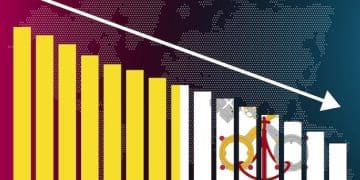Federal Reserve Rate Hikes: Impact on Small Business Lending in the US

The Federal Reserve’s anticipated interest rate hikes in the next six months are poised to significantly impact small business lending in the US, potentially leading to higher borrowing costs and reduced access to capital.
How will the Federal Reserve’s projected interest rate hikes affect small business lending in the next 6 months? This question is critical for small business owners across the US as they navigate the current economic landscape. Understanding the potential impacts can help businesses prepare and adapt to changing financial conditions.
Understanding the Federal Reserve’s Interest Rate Policy
The Federal Reserve (Fed) plays a vital role in managing the US economy through its monetary policy. One of the key tools it uses is adjusting the federal funds rate, which influences interest rates across the board. Let’s delve into how this mechanism works and why it matters for small businesses.
How the Federal Funds Rate Works
The federal funds rate is the target rate that the Federal Reserve wants banks to charge one another for the overnight lending of reserves. When the Fed raises this rate, it becomes more expensive for banks to borrow money. This increase is typically passed on to consumers and businesses in the form of higher interest rates on loans.
The Fed’s Goals and Recent Actions
The Federal Reserve’s primary goals are to maintain price stability (control inflation) and promote maximum employment. In recent months, the Fed has been aggressively raising interest rates to combat rising inflation. These rate hikes are intended to cool down the economy by making borrowing more expensive.

The Federal Reserve’s interest rate adjustments are a powerful tool for influencing economic activity. While these adjustments can help control inflation, they also have significant implications for small businesses seeking financing.
The Direct Impact on Small Business Loan Rates
Small businesses often rely on loans to fund operations, investments, and growth. When the Federal Reserve raises interest rates, these businesses are directly affected through higher borrowing costs. Let’s examine how these rate hikes translate into increased expenses for small business loans.
Increased Costs of Borrowing
As interest rates rise, the cost of borrowing increases for small businesses. This means that businesses will have to pay more in interest over the life of a loan. This can strain their finances and reduce their ability to invest in other areas of their business like expansions.
Types of Loans Affected
Several types of small business loans are affected by rising interest rates, including:
- Term Loans: These are loans with a fixed repayment schedule and are commonly used for major investments.
- Lines of Credit: These provide businesses with access to a revolving pool of funds.
- Commercial Mortgages: Used to purchase or refinance commercial properties.
Each of these loan types becomes more expensive as interest rates climb, impacting the overall financial health of small businesses.
The direct impact of Federal Reserve rate hikes on small business loan rates can significantly increase the financial burden on these businesses, affecting their profitability and growth potential.
Reduced Access to Capital for Small Businesses
Beyond the increased cost of borrowing, rising interest rates can also lead to reduced access to capital for small businesses. As lending becomes more expensive, banks may become more selective in their lending practices, which can disproportionately affect smaller enterprises.
Stricter Lending Standards
When interest rates are high, banks tend to tighten their lending standards. This means they become more cautious about who they lend money to, often favoring larger and more established businesses with stronger credit histories.
Impact on Marginal Businesses
Small businesses that are considered riskier borrowers – perhaps due to a shorter operating history or lower credit score – may find it harder to secure loans. This reduced access to capital can stifle their growth and even threaten their survival.

Reduced access to capital can severely limit the opportunities available to small businesses, hindering their ability to innovate, expand, and compete in the marketplace.
Strategies for Small Businesses to Adapt
While the prospect of rising interest rates can be daunting, small businesses can take proactive steps to mitigate the potential impact. By implementing strategic financial management practices, businesses can better navigate the changing economic landscape.
Improving Financial Management
One of the most effective strategies is to improve financial management. This includes:
- Budgeting and Forecasting: Create a detailed budget and regularly forecast cash flow to anticipate and manage expenses.
- Cost Cutting: Identify areas where costs can be reduced without compromising the quality of products or services.
- Efficient Inventory Management: Optimize inventory levels to minimize holding costs and prevent overstocking.
Exploring Alternative Financing Options
Small businesses should also explore alternative financing options, such as:
- Small Business Administration (SBA) Loans: These loans often come with favorable terms and lower interest rates.
- Crowdfunding: Platforms like Kickstarter and Indiegogo can provide access to capital from a wide range of investors.
- Venture Capital: For high-growth potential businesses, venture capital can be a valuable source of funding.
By adopting sound financial practices and exploring a variety of financing options, small businesses can enhance their resilience and adaptability in the face of rising interest rates.
The Broader Economic Context and Outlook
To fully understand the implications of Federal Reserve rate hikes on small business lending, it’s important to consider the broader economic context. The state of the economy, inflation trends, and government fiscal policies all play a role in shaping the lending environment.
Current Economic Conditions
As of today, the US economy is experiencing moderate growth, but inflation remains above the Federal Reserve’s target rate. This has prompted the Fed to continue raising interest rates, with further increases expected in the coming months.
Expert Opinions and Forecasts
Economists hold varying opinions on the future path of interest rates and their impact on small businesses. Some predict that the Fed will continue to raise rates aggressively until inflation is brought under control, while others believe that the Fed may soon pause or even reverse course if the economy shows signs of slowing down too much.
Government Policies and Support
Government policies can also play a crucial role in supporting small businesses during periods of economic uncertainty. Measures like tax credits, grants, and loan guarantee programs can help ease the financial burden on these businesses.
Understanding the intricate interplay of economic conditions, expert opinions, and government policies is essential for small businesses to make informed decisions and navigate the challenges posed by rising interest rates.
Case Studies: Small Businesses Navigating Rate Hikes
Examining real-world examples of how small businesses have responded to previous interest rate hikes can provide valuable insights and lessons. These case studies highlight different approaches and outcomes, offering practical guidance for businesses facing similar challenges today.
Success Stories
Some small businesses have successfully navigated rising interest rates by:
- Diversifying their revenue streams to reduce their reliance on debt financing.
- Investing in technology to improve efficiency and lower operating costs.
- Building strong relationships with their lenders to negotiate favorable loan terms.
Lessons Learned
Other businesses have struggled due to:
- Failing to anticipate the impact of rising rates on their cash flow.
- Over-relying on short-term debt to finance long-term investments.
- Lacking a clear financial strategy to manage their debt obligations.
By studying these case studies, small businesses can learn from both the successes and failures of their peers, gaining a deeper understanding of how to effectively manage their finances in a rising interest rate environment.
| Key Point | Brief Description |
|---|---|
| 📈 Rate Hikes | Federal Reserve increases interest rates to combat inflation. |
| 💸 Loan Costs | Small businesses face higher borrowing costs, affecting profitability. |
| 🚫 Capital Access | Banks tighten lending standards, reducing access to capital. |
| 💡 Strategies | Improve financial management and explore alternative financing options. |
Frequently Asked Questions
▼
Federal funds rate hikes refer to an increase in the target rate that the Federal Reserve wants banks to charge one another for the overnight lending of reserves, influencing interest rates across the US.
▼
As interest rates rise, the cost of borrowing increases for small businesses. This leads to higher interest payments on loans, which can strain their financial resources and reduce investment capacity.
▼
To prepare, small businesses should improve their financial management, explore alternative financing options, and build strong relationships with their lenders to negotiate favorable loan terms amid the changes.
▼
Yes, various types of small business loans, including term loans, lines of credit, and commercial mortgages, are affected by rising interest rates, impacting the overall financial health of the businesses.
▼
Banks often become more selective in periods of high interest rates, which can disproportionately affect smaller enterprises, ultimately reducing their opportunities for business development and growth.
Conclusion
The Federal Reserve’s projected interest rate hikes pose significant challenges to small business lending in the US. However, by understanding the potential impacts and implementing proactive strategies, small businesses can navigate these challenges and position themselves for continued success.




